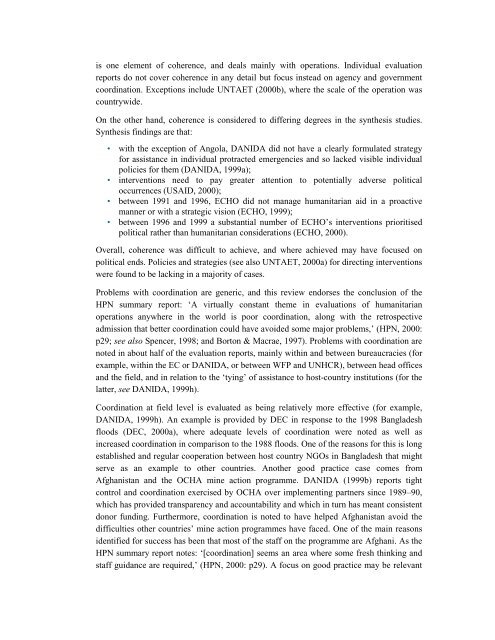Download PDF - ReliefWeb
Download PDF - ReliefWeb
Download PDF - ReliefWeb
Create successful ePaper yourself
Turn your PDF publications into a flip-book with our unique Google optimized e-Paper software.
is one element of coherence, and deals mainly with operations. Individual evaluation<br />
reports do not cover coherence in any detail but focus instead on agency and government<br />
coordination. Exceptions include UNTAET (2000b), where the scale of the operation was<br />
countrywide.<br />
On the other hand, coherence is considered to differing degrees in the synthesis studies.<br />
Synthesis findings are that:<br />
• with the exception of Angola, DANIDA did not have a clearly formulated strategy<br />
for assistance in individual protracted emergencies and so lacked visible individual<br />
policies for them (DANIDA, 1999a);<br />
• interventions need to pay greater attention to potentially adverse political<br />
occurrences (USAID, 2000);<br />
• between 1991 and 1996, ECHO did not manage humanitarian aid in a proactive<br />
manner or with a strategic vision (ECHO, 1999);<br />
• between 1996 and 1999 a substantial number of ECHO’s interventions prioritised<br />
political rather than humanitarian considerations (ECHO, 2000).<br />
Overall, coherence was difficult to achieve, and where achieved may have focused on<br />
political ends. Policies and strategies (see also UNTAET, 2000a) for directing interventions<br />
were found to be lacking in a majority of cases.<br />
Problems with coordination are generic, and this review endorses the conclusion of the<br />
HPN summary report: ‘A virtually constant theme in evaluations of humanitarian<br />
operations anywhere in the world is poor coordination, along with the retrospective<br />
admission that better coordination could have avoided some major problems,’ (HPN, 2000:<br />
p29; see also Spencer, 1998; and Borton & Macrae, 1997). Problems with coordination are<br />
noted in about half of the evaluation reports, mainly within and between bureaucracies (for<br />
example, within the EC or DANIDA, or between WFP and UNHCR), between head offices<br />
and the field, and in relation to the ‘tying’ of assistance to host-country institutions (for the<br />
latter, see DANIDA, 1999h).<br />
Coordination at field level is evaluated as being relatively more effective (for example,<br />
DANIDA, 1999h). An example is provided by DEC in response to the 1998 Bangladesh<br />
floods (DEC, 2000a), where adequate levels of coordination were noted as well as<br />
increased coordination in comparison to the 1988 floods. One of the reasons for this is long<br />
established and regular cooperation between host country NGOs in Bangladesh that might<br />
serve as an example to other countries. Another good practice case comes from<br />
Afghanistan and the OCHA mine action programme. DANIDA (1999b) reports tight<br />
control and coordination exercised by OCHA over implementing partners since 1989–90,<br />
which has provided transparency and accountability and which in turn has meant consistent<br />
donor funding. Furthermore, coordination is noted to have helped Afghanistan avoid the<br />
difficulties other countries’ mine action programmes have faced. One of the main reasons<br />
identified for success has been that most of the staff on the programme are Afghani. As the<br />
HPN summary report notes: ‘[coordination] seems an area where some fresh thinking and<br />
staff guidance are required,’ (HPN, 2000: p29). A focus on good practice may be relevant
















![CynefinFramework final [Read-Only]](https://img.yumpu.com/19017304/1/190x135/cynefinframework-final-read-only.jpg?quality=85)